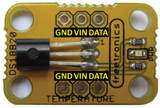You can make a wide varierty of test equipment with an Arduino, and some more accurate than others. However you can still find success towards the simpler end of the spectrum, and one example of this is by Instructables member JohnE12 and their electromagnetic interference detector.
This is based around an Arduino board with a long wire feeding into an analogue input. This can pick up all sorts of EMI and other signals - the strength of which is measured by the analogue to digital converter and the strength value approximated using a series of LEDs. The user then can easily walk around the area and determine the strength of EMI and thus possibly the source.

Although simple, this is a useful and also a fun tool to share with beginners as an exampel of using an analogue input. To learn more about this project, visit the Instructable page. And for more, we're on facebook, Google+, and twitter - so follow us for news and product updates as well.
If you need to add external hardware or devices to your next Arduino project, you'll need a protoshield to mount the external circuitry. In doing so, consider our range of ProtoShields. From the tiny LeoStick to the Mega we have a wide range to suit your application.

























